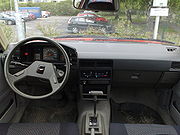Toyota Tercel: Difference between revisions
changed tense, no longer manufactured! |
|||
| Line 167: | Line 167: | ||
Toyota introduced the fourth generation Tercel in September 1990, as either a three-door hatchback or as a sedan with either two or four doors. In the North American markets it was powered by either a 1.5 L [[Toyota E engine#3E|3E-E]] engine producing {{convert|82|hp|kW|0|abbr=on}} at 5200 rpm (and {{convert|89|lbft|Nm|0|abbr=on}} of torque at 4400 rpm) or a 1.5-liter [[Toyota E engine#5E|5E-FE]] 16 valve DOHC producing {{convert|110|hp|kW|0|abbr=on}}. The hatchback was not offered in North America, while the two-door coupe was not sold in any market outside of the US and Canada. |
Toyota introduced the fourth generation Tercel in September 1990, as either a three-door hatchback or as a sedan with either two or four doors. In the North American markets it was powered by either a 1.5 L [[Toyota E engine#3E|3E-E]] engine producing {{convert|82|hp|kW|0|abbr=on}} at 5200 rpm (and {{convert|89|lbft|Nm|0|abbr=on}} of torque at 4400 rpm) or a 1.5-liter [[Toyota E engine#5E|5E-FE]] 16 valve DOHC producing {{convert|110|hp|kW|0|abbr=on}}. The hatchback was not offered in North America, while the two-door coupe was not sold in any market outside of the US and Canada. |
||
In Japan, the Tercel was also offered in 4WD versions. Hatchback models were VC, Joinus, and Avenue. Trim levels for the sedan were VE, VX, and VZ. The VZ is powered by a 5E-FHE engine. The higher level Japanese |
In Japan, the Tercel was also offered in 4WD versions. Hatchback models were VC, Joinus, and Avenue. Trim levels for the sedan were VE, VX, and VZ. The VZ is powered by a 5E-FHE engine. The higher level Japanese sedans have different tail lights and a better equipped interior than the export models. |
||
North American models were Base coupe, DX coupe, DX sedan, and LE sedan. Color-keyed bumpers, full wheel covers, and folded rear seat were optional on the DX, standard on the LE. The LE has red trunk garnish similar to Japanese model. |
North American models were Base coupe, DX coupe, DX sedan, and LE sedan. Color-keyed bumpers, full wheel covers, and folded rear seat were optional on the DX, standard on the LE. The LE has red trunk garnish similar to Japanese model. |
||
Revision as of 17:10, 4 August 2018
| Toyota Tercel | |
|---|---|
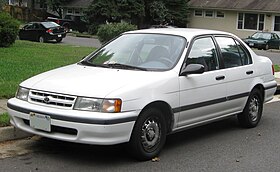 | |
| Overview | |
| Manufacturer | Toyota |
| Also called | Toyota Corolla Tercel Toyota Corsa Toyota Corolla II Toyota Soluna |
| Production | August 1978[1]–July 1999[2] |
| Assembly | Toyota, Aichi, Japan (Takaoka plant) Hamura, Tokyo, Japan (Hino plant) |
| Body and chassis | |
| Class | Subcompact |
| Chronology | |
| Successor | Toyota Vios (Asia) Toyota Platz/Echo |
The Toyota Tercel was a subcompact manufactured by Toyota from 1978 to 1999 across five generations, in five body configurations sized between the Corolla and the Starlet. Manufactured at the Takaoka plant in Toyota City, Japan, and sharing its platform with the Cynos (a.k.a. Paseo) and the Starlet, the Tercel was marketed variously as the Toyota Corolla II—sold at Toyota Japanese dealerships called Toyota Corolla Stores—and was replaced by the Toyota Platz in 1999. It was also known as the Toyota Corsa and sold at Toyopet Store locations. Starting with the second generation, the Tercel dealership network was changed to Toyota Vista Stores, as its badge engineered sibling, the Corolla II, was exclusive to Toyota Corolla Store locations.
The Tercel was the first front-wheel-drive vehicle produced by Toyota, establishing a layout and frame that was later used in other popular Toyota models.[2] For example, the Toyota Corolla E80's frame is similar to the AL20 Tercel's frame. Also, Toyota designed a new A engine for the Tercel, attempting simultaneously to achieve good fuel economy and performance and low emissions. Choice of body styles increased as well, with the addition of a four-door sedan.
The name "Tercel" derives from the Latin word for "one third" as the Tercel was slightly smaller than the Corolla[citation needed]—much the way "tiercel" refers to a male falcon, which is one-third smaller than its female counterpart. All Tercels were assembled at the Takaoka factory in Toyota City, Aichi or by Hino Motors in Hamura, Tokyo. Hino assembled the third generation Tercel from 1986 – 1990 for the two–door and some three–door models.
First generation (1978–1982)
| First generation (L10) | |
|---|---|
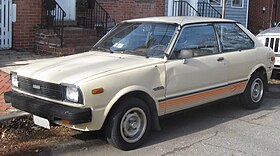 | |
| Overview | |
| Also called | Toyota Corsa |
| Production | August 1978[1]–April 1982[3] |
| Body and chassis | |
| Body style | 2-door coupe 4-door sedan 3-door hatchback |
| Layout | Front-engine, front-wheel-drive |
| Powertrain | |
| Engine | 1.3 L 2A I4 (AL11) 1.5 L 1A I4 (AL10) 1.5 L 3A I4 (AL12) |
| Transmission | 3-speed automatic 4/5-speed manual |
| Dimensions | |
| Wheelbase | 2,500 mm (98 in) |
| Length | 3,960 mm (156 in) (hatchback) 3,990 mm (157 in) (sedan) |
| Width | 1,555 mm (61 in) |
| Height | 1,355 mm (53 in) (hatchback) 1,375 mm (54 in) (sedan) |
The Tercel was introduced in Japan in August 1978,[1] Europe in January 1979[3] and the United States in 1980.[4] It was originally sold as either a two- or four-door sedan, or as a three-door hatchback. A version marketed in parallel through a separate distribution network in Japan was called the "Toyota Corsa".[5] In the United States it was named the "Corolla Tercel". Models sold in the US were powered by a 1452 cc SOHC four-cylinder engine producing 60 hp (45 kW). Transmission choices were either a four- or five-speed manual, or a three-speed automatic available with the 1.5 engine from August 1979 on.[6]
In the Japanese market, the 1500 engine developed 80 PS (59 kW) at 5600 rpm,[7] while the 1.3-liter 2A engine, added in June 1979, offered a claimed 74 PS (54 kW).[6] In Europe, mainly, the 1.3 version was available, with 65 PS (48 kW).[8]

In this new front-wheel-drive design, the first for Toyota, the engine is mounted longitudinally. The transmission is mounted under the floorpan, as is the case in a rear-wheel-drive car. Unlike a rear-wheel-drive car, the transmission has a ring and pinion gear on the front part of the transmission, underneath the engine. The engine, transmission and differential are located a little to the side from the centre line of the car, but still roughly in the centre. Halfshafts then extend from the transmission to the front wheels.
In August 1980, the Tercel (and Corsa) underwent a facelift, with considerable changes to the front and minor ones to the interior and rear. The 1A engine was replaced by the 3A of identical displacement but now with 83 PS (61 kW).[5]
Second generation (1982–1986)
| Second generation (L20) | |
|---|---|
 | |
| Overview | |
| Also called | Toyota Corolla II Toyota Corsa Toyota Sprinter Carib |
| Production | May 1982[3]–February 1988[9] |
| Body and chassis | |
| Body style | 3-door hatchback 4-door sedan 5-door hatchback 5-door station wagon |
| Layout | Front-engine, front-wheel-drive or four-wheel drive |
| Powertrain | |
| Engine | 1.3 L 2A I4 (AL20) 1.5 L 3A I4 (AL21/25) |
| Transmission | 3-speed automatic 4-speed manual 5-speed manual 6-speed manual |
Toyota redesigned the Tercel in May 1982, now called the Tercel in all markets. Its internal model code is the L20 series. It was available in three- or five-door hatchback models or a four-door station wagon, and also as a four-door sedan in Japan. The station wagon, known in Japan as the Sprinter Carib (Japanese: Toyota Sprinter Carib, short for "caribou"[9]), was introduced in August 1982. The wagon was also available with four-wheel drive (front-wheel-drive wagons were only available in select markets). In Japan, a four-wheel-drive sedan was also available, it too remained in production alongside the wagon version even after the introduction of the third generation Tercel. Standard front-wheel drive vehicles (and four-wheel drive wagons not equipped with the six-speed manual transmission) came with either a three-speed automatic or a four- or five-speed manual transmission. The four-speed manual was reserved for the very simplest version in North American markets.
As only the first two generations were sold officially in Europe, this was the last generation of the Tercel series available there, with either the hatchback or station wagon bodywork. In Japan, power outputs were as follows:
- 1,295 cc 2A-U: 75 PS (55 kW) at 6,000 rpm[10]
- 1,452 cc 3A-U: 83 PS (61 kW) at 5,600 rpm (9.0:1 compression, 82.05–86.05)[10]
- 1,452 cc 3A-U: 85 PS (63 kW) at 5,600 rpm (9.3:1 compression, 86.03–88.02)[10]
- 1,452 cc 3A-HU: 86 PS (63 kW) at 6,000 rpm (variable venturi carburetor, 9.3:1 compression, 82.05–84.08)[10][11]
- 1,452 cc 3A-SU: 90 PS (66 kW) at 6,000 rpm (twin variable venturi carburettors, swirl intake version, 84.08–88.02)[10]
North American Tercels were all fitted with the 1.5-liter engine, producing 63 hp (47 kW) at 4,800 rpm. In Europe, both the 1.3 (65 PS or 48 kW at 6000 rpm) and the 1.5 (71 PS or 52 kW at 5600 rpm) were available.[12] As with the earlier generation, engine and transmission were still mounted longitudinally, and the arrangements were the same. In some markets, engines received minor improvements, such as reformulated combustion chambers (to improve emissions and fuel economy), higher compression ratios, and new auxiliary devices for the carburettor assemblies.
The four-wheel-drive models (chassis code AL25, only with the 1.5 engine) could be equipped with six-speed manual transmissions, and could be shifted from two- to four-wheel drive without coming to a stop. The sixth gear it carries is an "extra low" (EL) first gear, a standard transmission gear with a very low (4.71:1) gear-ratio. The EL gear generates a 17.6:1 final drive ratio, giving the driver the torque needed to extract the vehicle from conditions which otherwise may have trapped it. It is only available when in four-wheel drive, and because of its low gear-ratio it is suitable only for very low-speed use. Also included with better equipped four-wheel-drive models was an inclinometer above the radio and air conditioner that measures the tilt of the car.
The new Tercel 4WD was built from existing pieces in the Toyota inventory. The engine, transaxle and front-wheel-drive system were from the existing Tercel. The coil-sprung, live rear axle was taken from the rear-wheel drive Corolla.[13] The only[citation needed] part specifically designed for the new Tercel 4WD was the transfer case, built into the transmission. This gives the driver greater versatility than was possible on a purely front-wheel-drive vehicle, as it provides three different power arrangements. Normally, the car is operated with front-wheel drive. When the driver pulls the 4WD selector lever back into four-wheel drive, or presses a button on the gear selector for the automatic transmission, front and rear differentials are driven at the same RPM via a direct mechanical coupling. There is no conventional center differential, so the four-wheel-drive system can be used only on loose or slippery road surfaces (such as snow, gravel, or sand); otherwise the drivetrain experiences severe wear, and handling is compromised. The third power option (which was only available on the six-speed manual) is low range. This is not the same as the low-range power option found in a truck or conventional SUV, as the Tercel lacks a high-range-low-range transfer case. When the lever is placed in four-wheel-drive mode it becomes possible to down shift the vehicle from first to EL.
In 1985 there were minor changes to gear ratios and to the grille design, and the interior was updated in 1986. The Tercel wagon (and four-door sedan in Japan) continued with the same design until February 1988 (when the Sprinter Carib was replaced by a larger, Corolla-based design), while the sedans and hatchbacks moved on to the newer design.[9]
Europe
Versions available in Europe:
- 1.3 DX (three-door hatchback, five-door hatchback)
- 1.3 GL (three-door hatchback, five-door hatchback)
- 1.5 GL (three-door hatchback, five-door hatchback)
- 1.5 4WD (five-door estate, only version from 1986 onwards)
Gallery
Third generation (1986–1990)
| Third generation (L30) | |
|---|---|
 | |
| Overview | |
| Also called | Toyota Corolla II |
| Production | May 1986[14]–1990 |
| Body and chassis | |
| Body style |
|
| Layout | Front-engine, front-wheel-drive |
| Related | Toyota Starlet |
| Powertrain | |
| Engine | |
| Transmission |
|
| Dimensions | |
| Wheelbase | 2,380 mm (93.7 in) |
| Length |
|
| Width | 1,626 mm (64 in) |
| Height |
|
| Curb weight | 730 kg (1,609 lb) |
In 1986, Toyota introduced the slightly larger third generation Tercel with a new 12-valve engine which featured a variable venturi carburetor, and later models with EFI. From this generation on, the engine is mounted transversely, with the transmission mounted on the right side of the engine in a layout developed by Dante Giacosa and earlier popularised in such vehicles as the Fiat 128 and Volkswagen Golf. Other improvements included revised rack-and-pinion steering and a newly designed, fully independent suspension. The Tercel continued in North America as Toyota's least expensive vehicle, while it was no longer offered in Europe. In other markets, the smaller Starlet was also offered.
In Japan, the top trim package GP-Turbo came installed with Toyota's four wheel independent suspension, labeled "Pegasus" and included active suspension technology called TEMS, along with their "Lasre" branded multi-port fuel injection, using the 3E-TEU engine. The GP-Turbo trim also came with a unique facelift, which included hidden headlamps.
In 1988, Toyota also introduced a 1.5L turbo diesel version 1N-T for the Asian market with a manual five-speed transmission.
The wagon version continued to be of the previous generation, as did the four-door sedan (which was not exported to most countries), and continued to be so until it was moved to the Corolla's underpinnings in 1988. The variable venturi carburettor reportedly has some problems, especially in the earlier models, such as a too rich mixture, which is caused by the too thin Teflon coating of the fuel-metering needle, which erodes over time due to friction. It also has had problems with the compensator (choke device), which can also cause overly rich mixture when not working properly.[15]
In 1987, Toyota introduced the Tercel EZ with less standard equipment: vinyl upholstery, a four-speed manual transmission, rubber mats instead of carpeting, and a deleted passenger's side sun visor.[15]
For the 1990 model year, the Tercel was available as either a three- or five-door hatchback or a two-door coupe, the wagon having been upgraded to the larger platform used for the Sprinter Carib. Also discontinued for 1990 was the four-wheel-drive system; the Tercel was then only available with front-wheel drive. Non-motorized two-point passive seatbelts for the front-seats were introduced in 1990.
Gallery
Fourth generation (1990–1994)
| Fourth generation (L40) | |
|---|---|
 Toyota Tercel DX sedan in the US | |
| Overview | |
| Also called | Toyota Corolla II |
| Production | September 1990[14]–1994 |
| Body and chassis | |
| Body style | 2-door coupe 3-door hatchback 4-door sedan |
| Layout | Front-engine, front-wheel-drive |
| Related | Toyota Paseo Toyota Starlet |
| Powertrain | |
| Engine | 1.5 L 3E-E I4 1.5 L 5E-FE I4 |
| Transmission | 3-speed automatic 4-speed manual 5-speed manual |
| Dimensions | |
| Wheelbase | 2,380 mm (93.7 in) |
| Length | 4,110 mm (161.8 in) |
| Width | 1,646 mm (64.8 in) (coupe) 1,661 mm (65.4 in) (sedan) |
| Height | 1,351 mm (53.2 in) |
| Curb weight | 914 kg (2,015 lb) |
Toyota introduced the fourth generation Tercel in September 1990, as either a three-door hatchback or as a sedan with either two or four doors. In the North American markets it was powered by either a 1.5 L 3E-E engine producing 82 hp (61 kW) at 5200 rpm (and 89 lb⋅ft (121 N⋅m) of torque at 4400 rpm) or a 1.5-liter 5E-FE 16 valve DOHC producing 110 hp (82 kW). The hatchback was not offered in North America, while the two-door coupe was not sold in any market outside of the US and Canada.
In Japan, the Tercel was also offered in 4WD versions. Hatchback models were VC, Joinus, and Avenue. Trim levels for the sedan were VE, VX, and VZ. The VZ is powered by a 5E-FHE engine. The higher level Japanese sedans have different tail lights and a better equipped interior than the export models.
North American models were Base coupe, DX coupe, DX sedan, and LE sedan. Color-keyed bumpers, full wheel covers, and folded rear seat were optional on the DX, standard on the LE. The LE has red trunk garnish similar to Japanese model.
The 1993 model saw a minor exterior redesign to the front and rear fascias and the addition of a standard driver's side airbag and available anti-lock brakes. The Tercel was carried over to 1994 with no major changes—Haloalkane, a non-CFC refrigerant was used in the air conditioning system.
Chile
In Chile, the Tercel was introduced in 1991 as a four-door sedan with a 1.3-liter, SOHC 12-valve 78 hp (58 kW), four-cylinder, carburetor engine, under the name "Corolla Tercel". The "DX" basic version came with tachometer and four spoke steering wheel. It gained moderate success due to the Corolla name.
In September 1992, a Canadian-spec version was introduced to Chile to replace the previous one with a new 1.5-liter SOHC engine. Unlike the previous one, it was simply called "Tercel". It was brought along the Canadian-spec Corolla to meet the new emission standard since no Latin American version of either was yet available with a catalytic converter. Due to the higher trim level of the Canadian-spec versions, the Tercel was initially marketed as a successor of the Corolla E90, which had just been discontinued. This made it a very successful car.
Gallery
Fifth generation (L50; 1994–1999)
| Fifth generation (L50) | |
|---|---|
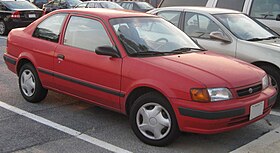 Toyota Tercel DX coupe in the US | |
| Overview | |
| Also called | Toyota Corolla II (JPN) Toyota Corsa (JPN) Toyota Soluna |
| Production | September 1994[14]–July 1999[2] 1996–2002 (Thailand) April 2000–May 2003 (Indonesia) |
| Assembly | Japan: Toyota, Aichi (Takaoka plant) Zhongli, Taiwan[16] (until 2003)[17] Malaysia: Subang, Selangor Thailand: Chachoengsao |
| Body and chassis | |
| Body style | 2-door coupe 3-door hatchback 4-door sedan |
| Layout | FF layout |
| Related | Toyota Paseo Toyota Starlet |
| Powertrain | |
| Engine | |
| Transmission |
|
| Dimensions | |
| Wheelbase | 2,380 mm (93.7 in) |
| Length | 4,120 mm (162.2 in) (1995–97) 4,133 mm (162.7 in) (1998–99) |
| Width | 1,646 mm (64.8 in) (1998–99) 1,661 mm (65.4 in) (1995–97) |
| Height | 1,351 mm (53.2 in) |
| Chronology | |
| Successor | Toyota Vios (Asia) Toyota Platz (Japan) |
In September 1994, for the 1995 model year, Toyota introduced an all-new Tercel. The new design offered a stiffer body[citation needed] with better handling and was one of only a handful of cars in the US to have OBDII in 1995. Retaining its compact packaging and high quality, the new Tercel featured a redesigned exterior and new engine. The Tercel now offered standard driver's and passenger's side airbags in the United States, but only a driver's side bag for Canada. Three-point seatbelts for front and outboard rear passengers and adjustable shoulder-belt anchor points for front seat passengers were installed on four-door models. All models met federal standards for 1997 side-impact protection, and offered anti-lock brakes. Standard models came with only a four-speed manual or automatic transmission and grey bumpers, while DX models were offered with the addition of body-colored bumpers and either a five-speed manual or four-speed automatic transmission.
Its all-new appearance appears to be influenced by the Japanese-market Toyota Camry V40 series, also introduced that year. Both vehicles were available together at Toyota Corolla Store Japanese dealerships.

In Japan, the Tercel was again also offered with the Corsa and Corolla II nameplates, for sale through parallel marketing channels. There was also a three-door hatchback body version offered in addition to the four-door sedan. The two-door coupe was only ever marketed in North America. There was also a four-wheel-drive option available in Japan.
The interior design pushed the dash further away, but brought the switches closer. This same dashboard (left sided version) was shared with the Toyota Starlet and Toyota Paseo of the time. The all-new DOHC 1.5 L I4 engine provides 93 hp (69 kW) and 100 lb⋅ft (140 N⋅m) of torque, offering a 13 percent power increase over the previous generation as well as a 15 percent increase in fuel economy. The new 5E-FE engine gets 45 mpg‑US (5.2 L/100 km; 54 mpg‑imp) on the highway with a five-speed manual transmission, making it the most fuel-efficient four-cylinder car of its time in the United States.[citation needed] As Toyota's entry-level car,the Tercel was also available with the smaller 1.3-liter 4E-FE and 2E gasoline four-cylinder, and the Toyota 1N-T engine; a 1,453 cc inline-four turbocharged diesel engine which provided 66 hp (49.2 kW) at 4,700 rpm and 96.1 lb·ft (130 N·m) of torque at 2,600 rpm.
For 1997, all Tercels were available only in the CE trim level and incorporated many of the standard and optional items from previous base and DX models. All Tercels came standard with a new 13-inch wheel and tire combination.
Inside, the Tercel's dashboard was revised with rotary ventilation controls. All Toyota models had revised seat fabric and door panels. The RedHawk and WhiteHawk editions were introduced in addition to the BlackHawk trim already offered, which came standard with air conditioning, 185/60R14 tires on custom wheels, a rear spoiler with integrated brake light, and hawk symbols to identify the special model.
Facelift

For 1998 the Tercel's styling was updated, highlighted by multi-reflector headlights, a revised grille and front fascia design and clear lens turn signal lights for the front and rear. The facelift occurred in December 1997 for the Japanese market, and covered all three lines (Tercel, Corsa, Corolla II).
The Tercel's rear styling was also enhanced with redesigned composite tail-lights and updated bumper molding. The new molding extended across the entire length of the rear bumper.
Production of the Tercel for the American market ended in 1998 as the model was superseded by the Echo. Production for Japan, Canada. and some other countries continued through 1999. Taiwanese production continued until 2003.[17]
In Paraguay and Peru, Tercels were still sold until the late-2000s, being replaced by Toyota Yaris.[clarification needed]
Chile
The fifth generation of Tercel was introduced in September 1995, presented in the FISA auto Show of that year as the "all new Tercel twin cam", available in three different levels: basic XLI, the medium GLI, and the full equipment LEI. All Tercels featured a 5E-FE 1.5 16v twin cam (DOHC) engine, rated at 100 hp (70 kW) at 6,400 rpm and 95 lb⋅ft (129 N⋅m) of torque at 3,200 rpm. With that engine the car took only 10.4 seconds from 0–60 mph. The car was revolutionary to that market at the time, and it was elected "car of the year" in Chile.[citation needed]
The XLi version was basic with no tach, and power steering was an option. The GLi had power steering, four arm steering wheels, trunk and gas cap remote opening; and three pointed rear seat belts standard. Finally, the LEi had all the equipment and AC; tachometer; rear seat belts, 175/70 13 tires, with power door locks, power windows with driver's side auto down, and four arm steering wheels. It was offered with either a five-speed manual transmission or a four-speed automatic.
The 1998 model had multi-reflector headlights, new fascia, bumpers and clear turn signal lights; in the rear, new mirror style taillights and new bumper. It was a huge success, becoming the second best-selling car in Chile for four years.
Asia
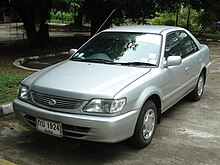

In Thailand, a version of the Tercel with different front and rear fascias was sold as the Toyota Soluna. The Soluna AL50 was powered by 1.5-liter 5A-FE engine, and campaigned as the Asian family car. The plain Soluna was a big seller in Thailand. Trim levels are XLi, SLi, and GLi.
Only the XLi and GLi were sold in Indonesia (since 2000), Singapore (since 1997), and Malaysia (since 1999), where the XLi was common for taxis. Based on the GLi, the Soluna S limited with body kits was offered for a short time.
The Tercel is also sold in Taiwan, which was manufactured and assembled by Kuozui Motors.
Dimension growth
The Tercel remained smaller than the Corolla throughout its production, though by the end of its production the Tercel had become almost the same size as the North American-market '75–'78 Corollas that were current at the time the Tercel was introduced.
| Dimension | 1995–1999 Tercel | 1975–1978 Corolla |
|---|---|---|
| Length | 4,120 mm (162.2 in) | 4,120 mm (162.2 in) |
| Width | 1,661 mm (65.4 in) | 1,585 mm (62.4 in) |
| Height | 1,349 mm (53.1 in) | 1,384 mm (54.5 in) |
| Wheelbase | 2,380 mm (93.7 in) | 2,370 mm (93.3 in) |
| Curb weight | 909 kg (2,005 lb) | 1,002 kg (2,210 lb) |
References
- ^ a b c Tercel Parts Catalogue (Japanese market)
- ^ a b c "Takaoka Plant History". toyota-global.com. Retrieved 2014-08-26.
- ^ a b c Toyota Vehicle Identification Manual. Japan: Toyota Motor Corporation – Overseas Parts Department. 1984. Catalog No.97913-84.
- ^ Finnish "Tekniikan Maailma" Magazine, 18/79
- ^ a b Car Graphic: Car Archives Vol. 11, '80s Japanese Cars (in Japanese). Tokyo: Nigensha. 2007. p. 8. ISBN 978-4-544-91018-6.
- ^ a b Car Graphic: Car Archives Vol. 5, '70s Japanese Cars (in Japanese). Tokyo: Nigensha. 2007. p. 9. ISBN 978-4-544-09175-5.
- ^ Lösch, Annamaria, ed. (1979). World Cars 1979. Pelham, NY: The Automobile Club of Italy/Herald Books. pp. 380–381. ISBN 0-910714-11-8.
- ^ Freund, Klaus, ed. (1980). Auto Katalog 1981 (in German). Vol. 24. Stuttgart: Vereinigte Motor-Verlage GmbH & Co. KG.
- ^ a b c Car Graphic '80s Car Archives, p. 26
- ^ a b c d e Car Graphic '80s Car Archives, pp. 9–10
- ^ World Cars 1984. Pelham, NY: L'Editrice dell'Automobile LEA/Herald Books. 1984. pp. 380–381. ISBN 0-910714-16-9.
- ^ Büschi, Hans-Ulrich, ed. (March 10, 1983). "Automobil Revue '83". 78. Berne, Switzerland: Hallwag, AG: 519, 593. ISBN 3-444-06065-3.
{{cite journal}}: Cite journal requires|journal=(help) - ^ Yamaguchi, Jack K. (1983), Lösch, Annamaria (ed.), "Japan: Seeking sane and prudent reconciliation", World Cars 1983, Pelham, NY: The Automobile Club of Italy/Herald Books: 65, ISBN 0-910714-15-0
- ^ a b c "Toyota Family Tree". toyota-global.com. Retrieved 2014-08-26.
- ^ a b "Toyota carburetor problems in FixYa". FixYa.com. Archived from the original on 2013-06-19. Retrieved 2013-04-11.
{{cite web}}: Unknown parameter|deadurl=ignored (|url-status=suggested) (help) - ^ "國瑞汽車股份有限公司 KUOZUI MOTORS, LTD". Kuozui.com.tw. Retrieved 2010-04-27.
- ^ a b "Kuozui Motors, Ltd. History". toyota-global.com. Retrieved 2014-08-26.






